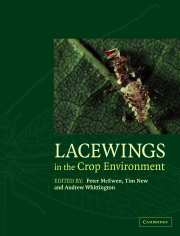Book contents
- Frontmatter
- Contents
- List of contributors
- Preface
- PART 1 Lacewing systematics and ecology
- PART 2 Lacewings in crops
- PART 3 Principles
- Introduction to Part 3
- CHAPTER 11 The use of lacewings in biological control
- CHAPTER 12 Mass-rearing, release techniques, and augmentation
- CHAPTER 13 Features of the nutrition of Chrysopidae larvae and larval artificial diets
- CHAPTER 14 Ecological studies of released lacewings in crops
- CHAPTER 15 Sampling and studying lacewings in crops
- CHAPTER 16 Interactions with plant management strategies
- CHAPTER 17 Lacewings, biological control, and conservation
- PART 4 Case studies
- PART 5 Conclusion
- Taxonomic index
- General index
CHAPTER 13 - Features of the nutrition of Chrysopidae larvae and larval artificial diets
Published online by Cambridge University Press: 04 May 2010
- Frontmatter
- Contents
- List of contributors
- Preface
- PART 1 Lacewing systematics and ecology
- PART 2 Lacewings in crops
- PART 3 Principles
- Introduction to Part 3
- CHAPTER 11 The use of lacewings in biological control
- CHAPTER 12 Mass-rearing, release techniques, and augmentation
- CHAPTER 13 Features of the nutrition of Chrysopidae larvae and larval artificial diets
- CHAPTER 14 Ecological studies of released lacewings in crops
- CHAPTER 15 Sampling and studying lacewings in crops
- CHAPTER 16 Interactions with plant management strategies
- CHAPTER 17 Lacewings, biological control, and conservation
- PART 4 Case studies
- PART 5 Conclusion
- Taxonomic index
- General index
Summary
INTRODUCTION
The potential for the use of predaceous Chrysopidae larvae as biological agents to control the density of noxious arthropods has been noted by many authors (New, 1975, 1988; Principi, 1983; Nordlund & Morrison, 1992). Appropriate technologies and equipment have been developed and continue improving which utilise eggs of the Angoumois grain moth Sitotroga cerealella and some other Lepidoptera as food for larvae under mass rearing of the most widely distributed representative of this family, Chrysoperla carnea. However, the high cost of C. carnea in mass production under these technologies (about $12.50 per 1000 larvae) does not currently allow wide application of this predator in the field (King & Coleman, 1989). The rationale of economic expediency and effectiveness of mass-rearing of Chrysopidae with their subsequent release against noxious insects has for over 50 years been promoting active research for different types of artificial food for these predators, in particular artifi- cial nutritional diets.
For insects, Singh (1977) defined artificial nutritional diets as any food which is prepared by a human being using various methods and on which insects can develop in captivity. Artificial food substrates for predaceous and parasitic insects include artificial nutritional diets (including alternative or substitute preys and hosts), specially treated with the aim of improving conditions of entomophagous nutrition. These include thermal treatment, making coverage, impregnation of inert materials with liquid artificial nutritional diets, their jellying, encapsulation, etc.
Hodek (1978a) introduced the concept of adequate prey (food) for predaceous insects, under which he considered only food that provided normal development and reproduction for the predator.
- Type
- Chapter
- Information
- Lacewings in the Crop Environment , pp. 320 - 337Publisher: Cambridge University PressPrint publication year: 2001
- 3
- Cited by



